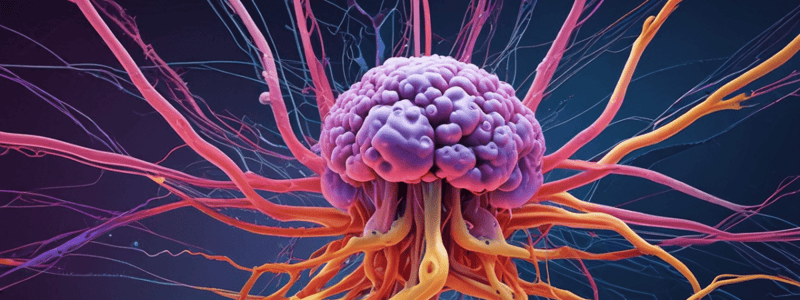Podcast
Questions and Answers
What is the main function of the lens in the eye?
What is the main function of the lens in the eye?
- To regulate the amount of light entering the eye
- To produce an image on the optic nerve
- To absorb light and protect the eye
- To refract light and focus it onto the retina (correct)
What happens to the image formed on the retina?
What happens to the image formed on the retina?
- The image is formed upside-down on the retina (correct)
- The image is blurry and unfocused
- The image is right-side up
- The image is projected directly onto the optic nerve
What is the main reason humans and most mammals cannot see infrared light?
What is the main reason humans and most mammals cannot see infrared light?
- Humans lack the necessary receptors to detect infrared light (correct)
- Infrared light is not visible to the human eye
- Infrared light is absorbed by the lens
- Infrared light is not refracted by the lens
What is the main purpose of the lens in the eye?
What is the main purpose of the lens in the eye?
What is the composition of the lens in the eye?
What is the composition of the lens in the eye?
What is the main symptom of Syringomyelia?
What is the main symptom of Syringomyelia?
Which condition is associated with bilateral loss of pain and temperature sensation?
Which condition is associated with bilateral loss of pain and temperature sensation?
What is the characteristic symptom of Phantom Pain?
What is the characteristic symptom of Phantom Pain?
How does Herpes zoster reach the spinal ganglia?
How does Herpes zoster reach the spinal ganglia?
Which area of the body does Phantom Feeling (phantom pain) typically originate from?
Which area of the body does Phantom Feeling (phantom pain) typically originate from?
What is a common consequence of Syringomyelia in terms of sensory perception?
What is a common consequence of Syringomyelia in terms of sensory perception?
What type of receptors are Hair Follicle Receptors?
What type of receptors are Hair Follicle Receptors?
What constitutes a 'sensory unit'?
What constitutes a 'sensory unit'?
What determines the intensity of a stimulus?
What determines the intensity of a stimulus?
According to the Law of Specific Energies, what does not change as the intensity of a stimulus increases?
According to the Law of Specific Energies, what does not change as the intensity of a stimulus increases?
Which of the following can affect senses through central excitation or central inhibition states of the nervous system?
Which of the following can affect senses through central excitation or central inhibition states of the nervous system?
Which part of the body has the highest two-point discrimination ability?
Which part of the body has the highest two-point discrimination ability?
What type of receptors are responsible for proprioception, fine touch, and fine pressure?
What type of receptors are responsible for proprioception, fine touch, and fine pressure?
Which law states that all sensory fibers enter the spinal cord via dorsal roots, and all motor fibers leave the spinal cord via ventral roots?
Which law states that all sensory fibers enter the spinal cord via dorsal roots, and all motor fibers leave the spinal cord via ventral roots?
Which structure is the first neuron in the dorsal column-medial lemniscus system?
Which structure is the first neuron in the dorsal column-medial lemniscus system?
Which symptom is associated with lesions in the dorsal column-medial lemniscal system?
Which symptom is associated with lesions in the dorsal column-medial lemniscal system?
Which structure is the third neuron in the dorsal column-medial lemniscus system?
Which structure is the third neuron in the dorsal column-medial lemniscus system?
What type of neurotransmitter do all sensory fibers release?
What type of neurotransmitter do all sensory fibers release?
What is the role of HCO3− in saliva?
What is the role of HCO3− in saliva?
Which enzyme catalyzes the formation of H2CO3 in intracellular fluid?
Which enzyme catalyzes the formation of H2CO3 in intracellular fluid?
What is the primary active process involved in transporting H+ and K+ against their electrochemical gradients?
What is the primary active process involved in transporting H+ and K+ against their electrochemical gradients?
Which drug is used to inhibit the H+-K+ ATPase in gastric parietal cells?
Which drug is used to inhibit the H+-K+ ATPase in gastric parietal cells?
What is responsible for the 'alkaline tide' observed in gastric venous blood after a meal?
What is responsible for the 'alkaline tide' observed in gastric venous blood after a meal?
How is Cl− transported into the lumen of the stomach?
How is Cl− transported into the lumen of the stomach?
Flashcards are hidden until you start studying




